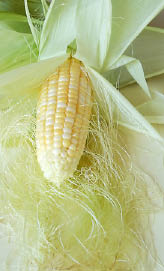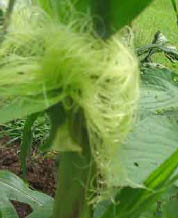|
Search Term: " Maize "
Peppermint essential oil exhibits powerful antifungal activity
Date:
January 10, 2019 08:47 AM
Researchers in India had a problem: fungi in grains that are stored in bulk where making people sick. grains once coated with industrial chemicals to prevent this dangerous fungi from forming prevented the food borne illness, but posed a separate threat to human and animal health in their own right. They decided to try peppermint oil, which possesses anti microbial, anti fungus, and anti oxidative properties to coat the grains for storage as a natural and healthy alternative and have had stellar results in not only repelling the fungi, but vermin as well. Key Takeaways:
"Indian researchers believe the essential oil of the plant can serve as a natural fungicide for Fusarium head blight." Read more: https://www.naturalnews.com/2019-01-02-peppermint-essential-oil-powerful-antifungal.html
(https://vitanetonline.com:443/forums/Index.cfm?CFApp=1&Message_ID=5951) Corn Silk
Date:
October 16, 2009 03:57 PM
Once used by the Inca tribe, cornsilk is thought to have originated in Central America. Traditionally, this herb was used to treat urogenital infections. Cornsilk is also used for bladder complaints, as it has a great cleansing effect on the urea as it circulates. This herb is also extremely valuable for the treatment of renal and cystic inflammation. Cornsilk helps with kidney problems, inflamed bladder, and prostate gland problems. This herb may be helpful for bed-wetting that is caused by an inflamed bladder. Additionally, it works to rid the body of morbid deposits by using the antiseptic properties that it is equipped with. Cornsilk has been used by physicians as a diuretic for conditions of cystitis.
Some herbalists believe that cornsilk is best when it is used fresh. However, it also can be found in dried forms. Although cornsilk is typically collected from the female flower or from corn cobs, cornsilk is available commercially in powdered and capsule form and as an extract. Cornsilk is often brewed as a tea and is considered to be very soothing as a beverage. This tea or infusion can be made by pouring one cup of boiling water over two teaspoons of dried cornsilk. Then, the mixture is covered and steeped for ten to fifteen minutes. It is recommended that this tea be consumed three times each day. Additionally, a tincture of one teaspoon of cornsilk can be taken three times each day. This tincture can be purchased over the counter or made at home. At home, it is made by mixing the herb with water or alcohol at a ratio of 1:5 or 1:10. Cornsilk can also be purchased in capsule form with the usual dosage for 400-mg capsules being two capsules with meals three times daily. The silk of cornsilk is used to provide alterative, antilithic, antiseptic, cholagogue, diuretic, demulcent, lithotriptic, mucilant, and mild stimulant properties. The primary nutrients found in this herb are silicon, PABA, and vitamins K and B. Primarily, this herb is extremely beneficial in dealing with heart conditions, kidney problems, urinary incontinence, and urinary problems. Additionally, this cornsilk has been proven to be extremely helpful in treating arteriosclerosis, bed-wetting, high blood pressure, high cholesterol, cystic irritations, gonorrhea, obesity, and prostate problems. For more information on the many beneficial effects provided by cornsilk, please contact a representative from your local health food store.
(https://vitanetonline.com:443/forums/Index.cfm?CFApp=1&Message_ID=2103) HISTORY
Date:
June 23, 2005 10:53 AM
HISTORY Known to the natives of the tropical Americas for millennia, Capsicum, or Cayenne Pepper, was introduced to Europe by Christopher Columbus and became known as “Guinea Pepper. ” Originally used by Native Americans located south of the Mexican border, archeological evidence supports its cultivation from 7000 B.C. Apparently, mixing chocolate and red chiles was a taste treat exclusively reserved for Aztec royalty.5 The exact origin of the word Capsicum remains somewhat of a mystery. However, it is assumed to be a derivative of the Greek word kapto, meaning “to bite,” an appropriate reference to its fiery pods. Capsicum is the fruit of a shrub-like tropical plant and is technically considered a berry. Its designation as a “pepper” can be traced back to Columbus, who equated its hot taste sensation with that of black pepper. In 1597, Gerard referred to Capsicum as extremely hot and dry and prescribed it for throat and skin infections. Health practitioners of the nineteenth century called phsysiomedicalists used Capsicum to counteract rheumatism, arthritis, depression and chills. In the early 1800s, Dr. Samuel Thompson utilize d Capsicum as a potent and safe natural stimulant. His followe r s , who would become known as Thomsonians, believed that Capsicum should be used to treat a wide variety of diseases. It was used orally and as a poultice to treat tumors, toothaches, feve r s , and respiratory ailments. In 1804, Dr. John St e vens introduced the red pepper to England where it became the catalyst component in a variety of herbal blends. Subsequently, herbal and medical practitioners used Capsicum to fight infection and sustain the natural heat of the body. It became well known in American dispensatories and pharmacopeia. In 1943, The Dispensary of the United States recorded that, “Capsicum is a powe rful local stimulant, producing when CAPSICUM swallowed, a sense of heat in the stomach and a general glow over the body without narcotic effect.”6 Twentieth-century physicians recognized the medicinal value of Capsicum which eventually found its way to the American Illust rated Medical Dictionary, the Merck Manual and Materia Medica, where it was referred to as a rubefacient, local stimulant, counter-irritant, gastric stimulant, and diaphoretic.7 Today Mexican Indians continue to use Capsicum as an internal disinfectant and protectant against contaminated food and also to treat fevers.8 “Today the pepper is nowhere in the world more appreciated and more widely used than in Mexico and certain other Latin American countries, which together form the original home of all the peppers. Both at morning and at evening, practically eve ry dish the Indians eat included Capsicum, just as their food did 2,000 years ago. The diet of the Indians was, and still is, rather bland . . . Maize, beans, squash, pumpkin, yucca, potatoes . . . little wonder that the pepper was so highly regarded. And of course . . . the peppers were a wonderful source of essential vitamins in a diet otherwise lacking in them.”9 Capsicum continues to be a source of vitality and health in numerous countries including the Bahamas and Costa Rica, where it is used to overcome colic or indigestion, in Africa for vascular disorders and by North Americans who use it as a tonic and natural stimulant. Capsicum is currently experiencing a renaissance in that a number of recent studies have emerged adding to its already impressive list of actions. Scientists are taking notice and looking at Capsicum with new respect and interest. Perhaps what sets Capsicum apart is that unlike powe rful pharmaceutical stimulants and pain killers, Capsicum possess potency without deleterious side effects.
(https://vitanetonline.com:443/forums/Index.cfm?CFApp=1&Message_ID=404) | ||||||||||||||||||||||||


 Cornsilk is an herbal remedy that is made from stigmas, which are the yellowish thread-like strands, found inside the husks of corn. Stigmas are found on the female flower of corn and are a member of the grass family. This part of the corn plant measurers four to eight inches long and is collected for medicinal use before the plant is pollinated.
Cornsilk is an herbal remedy that is made from stigmas, which are the yellowish thread-like strands, found inside the husks of corn. Stigmas are found on the female flower of corn and are a member of the grass family. This part of the corn plant measurers four to eight inches long and is collected for medicinal use before the plant is pollinated. 




